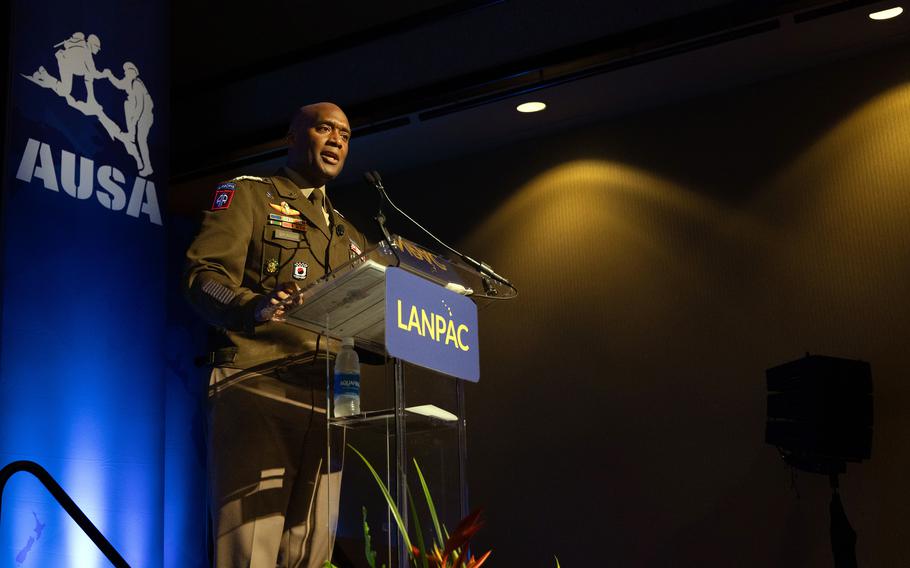
Army Gen. Xavier Brunson, commander of U.S. Forces Korea, delivers a keynote presentation at the Land Forces Pacific Symposium in Waikiki Beach, Hawaii, May 15, 2025. (Johanna Pullum/U.S. Army)
The top U.S. commander in South Korea likened the peninsula’s strategic location in the Indo-Pacific to a “fixed aircraft carrier floating in the water” near China, during a keynote address Thursday in Hawaii.
Army Gen. Xavier Brunson, who leads U.S. Forces Korea, delivered remarks at the Army’s Land Forces Pacific Symposium in Waikiki Beach, urging attendees to rethink the significance of land-based power in the region.
“What immediately stood out to me as I looked at the map was the position of the Korean Peninsula and the fact that it’s on the Asian continent, has a sizable U.S. force posture, is inside the first island chain, and is the closest allied presence to Beijing,” he said.
Brunson added: “At night, from a satellite image, [South Korea] looks like an island or like a fixed aircraft carrier floating in the water between Japan and mainland China.”
He emphasized the need for military strategists to go beyond conventional north-oriented map views and consider regional geography when assessing strategic positioning.
Roughly 28,500 U.S. troops are stationed in South Korea, most of them at Camp Humphreys in Pyeongtaek, about 40 miles south of Seoul.
While USFK’s primary mission is to defend the South against a potential North Korean attack, the command’s presence also plays a role in deterring China, one of Pyongyang’s closest allies.
After the United States deployed its $800 million Terminal High-Altitude Area Defense, or THAAD, system to South Korea in 2017, China complained that the move threatened its regional interests, then slapped broad boycotts against Seoul.
The Korean Peninsula “sits right in the center” of the map of Asia, Brunson said, adding that South Korea, Japan and the Philippines form a “triangle of nations” that are connected to the U.S. through mutual defense treaties.
Japan and the Philippines often clash with China over territorial disputes. Earlier this month, Japan’s Foreign Ministry accused a Chinese helicopter of entering its airspace near the Senkaku Islands, prompting its air force to scramble fighter jets.
Japan and China have asserted competing claims to the Senkakus, a group of five islets roughly 250 miles west of Okinawa.
Filipino vessels have also confronted Chinese ships in the South China Sea, with some encounters resulting in injuries.
“Our presence in the region gives our adversaries pause and ultimately supports the defense of the homeland from freedom’s front yard,” Brunson said. “By being forward-stationed, we effectively operate inside an adversaries anti-access area denial bubble and inside their headspace.”
In addition to leading USFK, Bruson also heads United Nations Command and the U.S.-South Korea Combined Forces Command, all headquartered at Camp Humphreys. He assumed command on Dec. 20, succeeding retired Army Gen. Paul LaCamera.